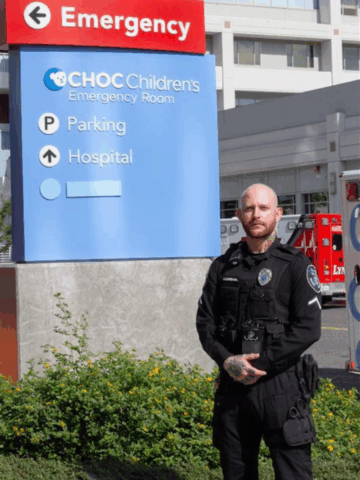By Dr. Georgie Joven-Pechulis, pediatric hospitalist at CHOC
What is a pediatric hospitalist? We are your general pediatricians when your child is admitted to the hospital. I like to think of hospitalists as air traffic control in the busy whirlwind of a child’s hospitalization. There are many clinicians on your child’s care team, but we help direct the flow of traffic and unite everyone in communication and management. CHOC Hospital in Orange and CHOC at Mission Hospital provides 24-hour hospitalist coverage to provide the best care for our patients.
5:30 a.m.― Alarm goes off. I may or may not be already awake depending on how my three kids ages 5 and under slept that night. So, my alarm is either my cellphone’s gentle tune or a screaming toddler. Dress, feed, and tend to all kids as we all fluster to get ready for the morning. In between walking our family’s dog and making school lunches, I brew my coffee and pack my “to go” breakfast. On my drive to CHOC, I listen to a pediatric podcast to get into the work mindset.
7:30 -8:00 a.m.― I arrive at CHOC. My team covers CHOC Hospital in Orange and CHOC at Mission Hospital, but today I’m rounding in Orange. When I arrive, I obtain my list of patients from my night-shift colleagues and learn about the patients ’conditions and overnight events. We usually talk over tough cases and run things by each other for discussion. One patient had increased seizures and required emergent anti-epileptic medications. One patient developed increased respiratory distress and needed to be switched to high-flow oxygen. Another patient was vomiting and unable to tolerate his diet, so IV fluid hydration needed to be established. I look over my patient list and make a plan for what order to visit patients that morning. I also review lab results for my patients and any imaging they’ve recently had done.
8:00 a.m. – 12:00 p.m. ― Every morning, our team does bedside rounds to learn about our patients’ overnight and current events. The care team is made up of doctors, pharmacists, bedside nurses, social work, nutrition, and case management. With bedside rounds, we visit every patient’s room (and sometimes have to search for them in playrooms), examine them and establish our plan for today and for discharge. Parents are encouraged to participate in family-centered rounds. They ask great questions, and some need emotional support. Some of the children we see during rounds are not feeling well, and others require playful interactions to break the ice. I make silly faces, tell horribly bad jokes, and discuss Elsa’s upcoming Frozen 2 movie to gain trust from the little patients to perform a physical exam. Usually I can reach some sort of common ground and I work hard to get there. Diagnoses of the patients we see can range from pneumonia, bronchiolitis, gastroenteritis, and seizures to even more complex cases with elaborate medical histories. Our patient lists can run from a handful of patients to over twenty during the busy winter season.
12:00 p.m. – 1:00 p.m. ― Time for lunch, and a chance to go over the day’s events with my fellow hospitalists. We talk, and I listen to everyone’s expertise. We manage to also chit-chat about life and hopefully share a laugh or two to lighten the mood. A few times a year, I also teach noon conference or morning report to our pediatrics residents. We are a training hospital, so we help teach the next generation of pediatricians through case report presentations and specific pediatric lectures.
1:00 p.m. – 3:00 p.m. ― This afternoon I spend a couple hours in meetings, including multidisciplinary care rounds (similar to this morning’s rounds but with a variety of specialists), meetings with patients’ parents, and medical staff committees. I help run the Morbidity and Mortality cases every month, where we discuss ways to improve patient care. I make a few calls to pediatricians in the community whose patients I am caring for while they’re hospitalized and update them on their status and plan of care. I also spend some time circling back to rooms and families from the morning. A baby in my care develops a fever and requires a lumbar puncture, also called a spinal tap, to rule out meningitis. This is a procedure we routinely do where we draw fluid from the spine in the lower back. Another patient is developing a worsening rash, so we reevaluate their antibiotic regimen to make sure it is adequate. Lastly, an emotional teenager having a tough time needs some one-on-one sit-down advice. I pause, take a breath, and tackle each task one by one. Statuses of patients can change so quickly while they are admitted, and it keeps me on my toes.
3:00 p.m.- 5:00 p.m. ― I spend time updating patients’ charts and reviewing their plans of care. Part of this includes collaborating with other specialists and discussing certain cases. During this time, we also receive a few new patients from the emergency department. Some have obvious diagnoses and others were admitted to determine the root cause of their illness. Sometimes patients are admitted from our hospital’s emergency departments or transferred from others via ambulance or helicopter. Often times the work of a hospitalist feels like the TV show “House” because we are solving medical puzzles. Medicine is fascinating and thought-provoking, and part of the reason I love what I do so much.
5:00 p.m. – 8:00 p.m. ― Just like the morning frenzy, my evenings are a rush to pick up my kids, cook and eat dinner, pick up around the house, and walk the dog. These precious hours, although very busy, are a chance for me to spend some quality time with my family and learn about how their days went. We end our nightly family time with bedtime stories and lullabies.
8:00 p.m-10:00 p.m. ― By this time, my house is finally quiet. This is my chance to get out my yoga mat and do some flow yoga. My husband and I watch our favorite binge show of the season. After he goes to bed, I stay up a little later to check in on what’s going on with my patients and read to keep up to date with current articles in medical review journals.
I go to bed feeling thankful and to be able to do this every day as “work.” Often people tell me, “I can’t imagine doing your line of work,” but I can’t imagine doing anything else. I love who I work with and am grateful to be part of such an amazing place as CHOC.




